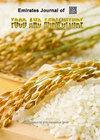Shotgun approach reveals distinctive lipid profiles in brassica oilseeds: A high-resolution ESI-ToF-MS study
IF 0.7
4区 农林科学
Q3 AGRONOMY
引用次数: 0
Abstract
Members of Brassica seed oil are important sources of nutritionally superior edible oil. There are no comprehensive reports on complete lipidomic profile of these oilseed crops. In this study, the lipidomic profiling of edible oil from 7 different cultivated species of Brassica seed oils was performed by shotgun approach using electrospray High Resolution Time of Flight-Mass Spectrometry (ESI-ToF-MS). The mass spectrum under positive polarity revealed 1098 lipids under different lipid classes including sphingolipids, phospholipids and different storage lipids. Under negative polarity, 70 lipids including free fatty acids (FFA), cardiolipins and phospholipids were detected. Erucic acid in FFA form was found to be most abundant in both Yellow and Brown sarson. Brassica napus contains almost all forms of cardiolipins (CL). Out of 26 different species of cardiolipins detected in negative ion mode, CL 56:1 (FA 18:1) and CL 56:1 (FA 22:1) were present only in brown sarson. Similarly, CL 56:2 (FA 18:2) and CL 56:1 (FA 22:1) were present only in Yellow and Brown sarson. These findings enhance our understanding of the nutritional diversity in Brassica seed oils, emphasizing the significance of lipidomic analysis for elucidating the molecular composition of edible oils.霰弹枪方法揭示了油菜籽中独特的脂质特征:高分辨率 ESI-ToF-MS 研究
芸苔属油料作物是营养丰富的食用油的重要来源。目前还没有关于这些油料作物完整脂质体图谱的全面报道。本研究采用电喷雾高分辨率飞行时间质谱法(ESI-ToF-MS),对 7 种不同栽培芸苔属油料作物的食用油进行了脂质组学分析。在正极性条件下,质谱显示出 1098 种不同脂类的脂质,包括鞘脂类、磷脂类和不同的贮藏脂类。在负极性条件下,检测到 70 种脂类,包括游离脂肪酸(FFA)、心磷脂和磷脂。在黄沙生和褐沙生中,游离脂肪酸形式的芥酸含量最高。芥蓝几乎含有所有形式的心磷脂(CL)。在负离子模式下检测到的 26 种不同的心磷脂中,CL 56:1 (FA 18:1)和 CL 56:1 (FA 22:1)只存在于褐沙糖中。同样,CL 56:2 (FA 18:2) 和 CL 56:1 (FA 22:1) 也只存在于黄沙星和棕沙星中。这些发现加深了我们对芸薹属植物籽油营养多样性的了解,强调了脂质体分析对阐明食用油分子组成的重要意义。
本文章由计算机程序翻译,如有差异,请以英文原文为准。
求助全文
约1分钟内获得全文
求助全文
来源期刊

Emirates Journal of Food and Agriculture
AGRONOMYFOOD SCIENCE & TECHNOLOGY&nb-FOOD SCIENCE & TECHNOLOGY
CiteScore
1.80
自引率
0.00%
发文量
18
期刊介绍:
The "Emirates Journal of Food and Agriculture [EJFA]" is a unique, peer-reviewed Journal of Food and Agriculture publishing basic and applied research articles in the field of agricultural and food sciences by the College of Food and Agriculture, United Arab Emirates University, United Arab Emirates.
 求助内容:
求助内容: 应助结果提醒方式:
应助结果提醒方式:


